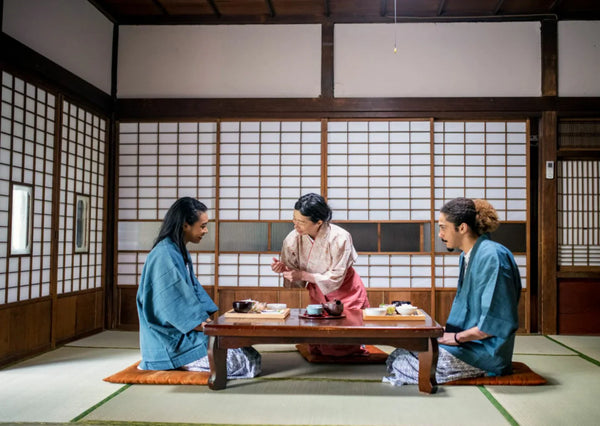
Jump to:
For many travelers, a journey to Japan means experiencing a different way of life.
Be it traveling solo, as a couple, or on family trips in Japan, people seek out experiences in a culture that values simplicity, hospitality, and mindfulness. And nowhere is that better expressed than in the experience of staying at a ryokan.
Ryokan are traditional Japanese inns that have been part of Japan’s travel culture for centuries.
Why stay in one? Well, a ryokan stay is an immersive cultural experience that brings together architecture, cuisine, bathing, and hospitality in a uniquely Japanese way. Sounds like something you might be interested in? Yeah, we kinda thought so.
What Is a Ryokan?

Ryokan originated during the Edo period (1603–1868) as rest stops for travelers along Japan’s key highways.
Positioned near hot springs or post towns, ryokan offered food, shelter, and warmth for samurai, merchants, pilgrims and other road warriors.
Today, the ryokan concept has evolved, but the soul of the ryokan remains unchanged. From snowy mountain towns to seaside villages, staying in a ryokan connects you to Japanese traditions.
A ryokan is a great way to experience understated elegance, respect (for people and for nature), and seasonal harmony.
Modern ryokan range from lavish resorts with garden views and gourmet meals to modest, family-run establishments offering warmth and authenticity on a budget. Regardless of the price, the essence is the same: guests are treated with omotenashi.
Omo-what now? Omotenashi is a deeply rooted Japanese ethos of attentive, sincere hospitality. Stay in a ryokan and you’ll learn all about it, in the best way possible!
How a Ryokan Differs from a Western Hotel

From the moment you arrive, a ryokan feels different.
The entrance may be quiet and unassuming. No neon signs or big marquee here. More like a stone pathway or a small lantern-lit garden.
Inside, you’ll remove your shoes and step onto tatami (straw) flooring, where an oasis of peaceful simplicity awaits.
Rooms in a ryokan are minimal yet elegant, typically featuring tatami mats, sliding paper doors, and futon beds that are rolled out at night.
There are no towering beds or wall-mounted TVs. Instead, you might find a tokonoma alcove with a seasonal flower arrangement or a scroll of calligraphy, a low table with floor cushions, and large windows that invite in natural light.
Meals in a ryokan are another distinct difference. Many ryokan offer dinner and breakfast included with your stay, typically served in your room or in a traditional dining hall.
These meals often feature kaiseki, a seasonal multi-course dining experience showcasing local specialties and meticulously plated dishes. Breakfast, too, is a cultural opportunity, often consisting of something like: grilled fish, rice, miso soup, pickles, and a soft-boiled egg.
One of the most cherished features of a ryokan is the bath. Whether fed by a natural hot spring or filled with heated water, ryokan baths (and especially onsen) are places to relax, reflect & restore (R&R and more R!).
These baths are often communal and separated by gender. But many ryokan now offer private baths, either en suite or reservable (important if you or a traveling party member has tattoos – see below).
Service is quiet yet thorough. A staff member, often dressed in kimono, may guide you to your room, pour your first cup of tea or set up your futon while you dine. Sound lovely?
What to Expect When Staying at a Ryokan

Checking into a ryokan is kinda like stepping into a slower, more mindful way of being.
You’ll be greeted with a bow, perhaps a warm towel or seasonal sweets, and taken to your room where a tea set often awaits.
After settling in, you might change into a yukata, a casual cotton robe provided for your comfort during your stay.
Dinner is usually served on the early side, between 6 and 7 p.m.and it’s best to arrive at the ryokan no later than 5 p.m. to make the most of the experience (pro tip: be respectful in your arrival time and let the staff know in advance when you want to eat and whether you have any dietary needs).
If your meal is included, it will be an event in itself: beautifully presented, thoughtfully paced, and crafted around the local season.
After dinner, a staff member will prepare your futon bedding. The thick mattress is laid directly on the tatami floor, accompanied by a fluffy comforter and pillow. Many international guests are surprised at how well they sleep in Japan this way.
In the morning, breakfast awaits at your ryokan, often practically as elaborate as dinner. It's a refreshing and grounding way to start the day.
As you prepare to check out, you’ll find the same warmth and formality that greeted you on arrival. Guests are often bowed out, with staff lining up to thank you for your stay.
The Onsen Experience at a Japanese Ryokan

Many ryokan, especially those in mountainous or coastal regions, feature onsen.
What’s the deal with onsen, you ask?
Onsen are hot springs that draw from Japan’s abundant geothermal activity. These are more than having a bath or jacuzzi; they’re for healing, relaxation, and mental clarity.
Onsen etiquette is important to understand and observe. Before entering the bath, you’ll shower thoroughly at the washing stations. It’s customary to enter the onsen completely naked (swimsuits are not allowed), though you can bring a small towel to cover yourself while walking around. That towel should not go into the bath itself; leave it on the edge or on your head, if you like.
The water is typically quite hot, but deeply soothing. Many people find that soaking in an onsen after dinner and before bed leads to a fantastic night’s sleep.
Some ryokan even offer rotenburo (outdoor baths) which allow you to soak under the stars or while snow falls silently around you. Nice, right?!
If you have tattoos, it’s worth checking ahead of time. While some onsen still prohibit visible tattoos, an increasing number are becoming more accepting or offer private bathing options.
Kaiseki and the Art of the Seasonal Meal

Ryokan dining often feels like an education in Japanese culture and the natural world.
Kaiseki cuisine embodies balance, aesthetics & seasonality. Dishes are often presented on different ceramic plates, lacquerware, or wooden trays, each one chosen to highlight the ingredients.
A typical dinner might begin with a small bite such as sesame tofu or vinegared vegetables, followed by sashimi, a clear soup, grilled fish or wagyu beef, a simmered vegetable course, rice, pickles… and finally, a seasonal dessert.
Each bite is small but deliberate, meant to be savored slowly.
Breakfast carries on the same philosophy. You’ll receive a tray with freshly steamed rice, miso soup, grilled fish, pickled vegetables, tamagoyaki and green tea. It may be lighter than Western breakfasts in calories, but it feels satisfying and deeply nourishing.
Types of Ryokan: The Full Range
Not all ryokans are created equal. Here are the main categories you’ll encounter:
-
Luxury Ryokan: These offer private onsen, beautifully manicured gardens, artistic kaiseki meals, and impeccable service. Expect high prices, but also once-in-a-lifetime experiences.
-
Family-Run Ryokan: Often found in rural towns or suburbs, these are cozy, affordable & warmly personal. They may not offer elaborate meals, but the welcome is sincere.
-
Modern Ryokan: A hybrid of Western conveniences and Japanese style. Expect wifi, beds rather than futons… and sometimes buffet-style meals.
How to Book a Ryokan and What to Know Before You Go

Booking a ryokan is not quite like booking a standard hotel.
You’ll need to pay close attention to what’s included. Most listings will specify whether meals are included (usually both dinner and breakfast) and if baths are shared or private.
It’s often good to book directly through a ryokan’s website if they have English support, or use specialized platforms like Ryokan Collection or Rakuten Travel. Booking.com also offers ryokan listings, and the details are generally well laid out (well, some more than others).
Try to book a few months in advance, especially in popular areas like Hakone, Kyoto, or the Japanese Alps. If you have dietary restrictions, contact the property ahead of time. Many ryokan can accommodate vegetarians or food allergies (but not likes/dislikes/preferences, please), and they need advance notice.
Check-in times are typically between 3 pm and 5 pm, and check-out is often around 10 am. Plan your travel accordingly.
Best Places in Japan to Stay at a Ryokan

Japan is filled with regions that are perfect for a ryokan stay, but some stand out for their scenery, hospitality, and cultural richness.
-
Hakone: Just outside Tokyo, this resort area offers Mt. Fuji views, natural hot springs… and many ryokan with both indoor and outdoor baths.
-
Kinosaki Onsen: A small town famous for its onsen-hopping culture. Guests wear yukata and geta sandals to visit seven public baths.
-
Takayama: Nestled in the Japanese Alps, this small city features traditional architecture, markets, and local sake.
-
Beppu: One of Japan's geothermal regions. Try unique baths including sand and mud onsens.
-
Izu Peninsula: A scenic coastal escape with ocean views, fresh seafood, and open-air baths… within decent reach of Tokyo and yet a kind of hidden gem if you will
-
Tohoku or Shikoku: For a quieter, less touristy experience. Ryokan here offers warm welcomes and beautiful natural surroundings.
Check out our article on the Top 10 Onsen Experiences in Japan, too!
Bring the Onsen Experience Home

In Japan, unwinding after a long day often means soaking in a warm bath, letting stress melt away in the gentle scent of hinoki wood and calming aromas. Recreate that peaceful ritual at home with these Japanese essentials:
-
Imabari Bath Towels: Luxuriously soft and absorbent, made in Japan’s towel capital.
-
Umezawa Cypress Wooden Bath Stool: Crafted from aromatic hinoki for an authentic bathhouse touch.
-
Umezawa hinoki bath mat: Naturally water-resistant and beautifully minimal.
-
Umezawa cypress bath bucket: A must-have for rinsing and relaxation.
-
Hakugen Lavender Bath Salt: Infused with calming lavender to melt the stress away.
Don’t Miss a Ryokan Stay When You Visit Japan
A ryokan stay isn’t something you rush through or squeeze in between sections on sightseeing checklists.
It’s a conscious choice to experience a slower, more intimate side of Japan. The simplicity of the rooms, the quiet care behind each meal, the warmth of a bath… slow down and soak it all in (pun intended)
Spending a night at a ryokan offers something different from other accommodations. Honestly? It’s more about how you feel while you’re at the ryokan: cared for, welcomed & connected to a tradition that values presence over polish, service over shine.
Your ryokan stay doesn’t need to be fancy (though it sure can be). Even a modest ryokan can leave a lasting impression.
One good meal, one peaceful soak, and a good night’s sleep on tatami can tell you more about Japanese hospitality than the entirety of TikTok or Insta reels ever could.


0 comments